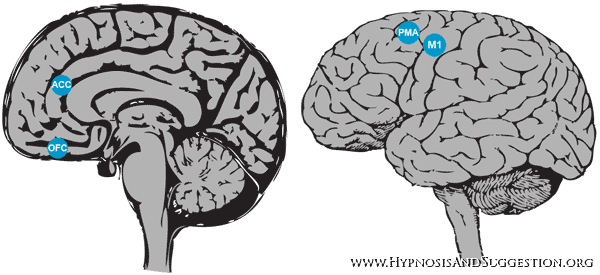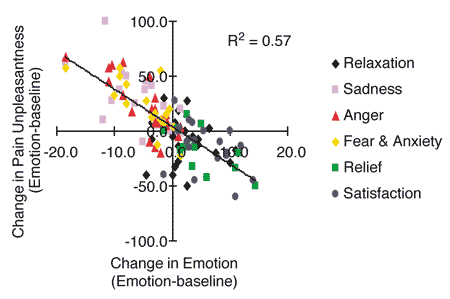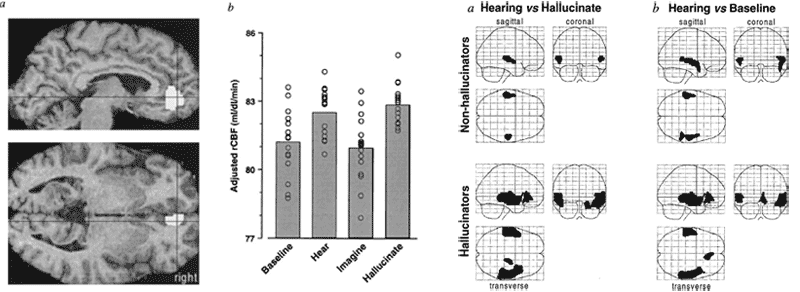Using hypnosis as a tool in research
Hypnotic suggestion can be used to model unusual conditions or behaviours in order to study them more closely. Used this way as a research tool hypnotic suggestion can be of significant use to psychologists, cognitive neuroscientists, and medical researchers. This page reviews a number of recent examples of this kind of use of hypnosis in research.
"Imaging techniques of the living brain may illuminate the anatomical and functional nature of hypnosis. Moreover, hypnosis can also be used as a tool to study cognitive phenomena, as we unravel some of the neural mechanisms subserving hypnotic expression." (Raz & Shaipro, 2002).
"As researchers who are not familiar with hypnosis gain confidence in its strategic use in mainstream psychological and neuropsychological work we can expect to see a resurgence in its popularity as a practical tool." (Oakley, 2006).
Using hypnosis to study conversion hysteria
Peter Halligan and colleagues conducted a series of studies which used hypnosis to investigate conversion disorder. Significant numbers of patients in neurology clinics report symptoms such as partial blindness, deafness or paralyses in the absence of observable physical or neurological causes. These 'medically unexplained' symptoms are often labelled conversion disorder. Many authors (Charcot, Janet, Oakley) have noted similarities between conversion disorder symptoms and phenomenon produced by suggestion in hypnosis - both are experienced involuntarily and feel 'real', and it is thought that similar brain mechanisms may explain both.
In a series of three studies Halligan and colleagues investigated cases of left leg paralysis - either in patients with conversion disorder, or deliberately created with hypnotic suggestion in healthy volunteers. Participants were scanned in a PET scanner while trying to move their (paralysed) left leg. When a healthy person tries to move as working limb the authors report activity in the premotor and motor areas in the brain, on the opposite side to the limb (right motor areas control left leg). In the study by Marshall et al (1997), when the patient with conversion paralysis tried to move their paralysed limb activity was observed in the premotor cortex (taken as evidence of an attempt-to-move) but activity in the motor cortex was lacking. Additional activity was observed in the right orbitofrontal cortex and right anterior cingulate cortex, the authors interpreted this as evidence of unconsicous inhibition of the movement attempt. You can see the regions involved on the diagram below:

Key: ACC = anterior cingulate cortex, OFC = orbitofrontal cortex, PMA = premotor area, M1 = motor cortex
Halligan et al (2000) replicated the Marshall et al (1997) study, this time using a healthy volunteer given a hypnotic suggestion that his left leg was paralysed. The pattern of brain activity seen when he attempted to move the paralysed limb was similar to that seen in the earlier study by Marshall et al. These two studies were later reinforced by a third study (Ward et al, 2003) designed to answer criticisms that participants in the first two studies were deliberately feigning their symptoms. This third study compared brain activity when participants were either trying to move a hypnotically paralysed limb, or trying to 'fake' a paralysis to trick a neurologist. The results demonstrated that hypnotically-induced paralyses resulted in different patterns of brain activity form those underlying deliberate feigning.
These studies are interesting because they demontrate the use of hypnosis as a research tool. Hypnotic suggestions were used to model clinical symptoms in order to more closely study the mechanisms behind the disorder. Oakley (2006) offers a fuller review of this series of studies.
Using hypnosis to study emotion (and emotional blunting)
Having suffered an extended lack of attention, the psychological study of emotion is now a thriving area of research. A number of studies have used hypnosis and hypnotic suggestion to investigate this key component of human consciousness.
The relationship between pain and emotion is an important area of research, with critical clinical application (Keefe et al, 2001). Laboratory studies of pain have been repeatedly criticised on the grounds that experimentally-induced pains are not sufficiently threatening to produce a strong emotional response, as is the case with 'real world' pains. Pierre Rainville and colleagues (2005) conducted a study at the Universite de Montreal using hypnotic suggestion to produce emotional states, and to examine the effects of these on pain perception. Critically, the emotional states were ones which are known to be related to clinical pain, such as sadness, anger and fear. They found that emotions of sadness, anger, and fear increased perceived pain, but that positive states such as satisfaction or anticipation of relief failed to relieve pain above the level produced by hypnotic relaxation. Further, they found that the changes in experienced pain unpleasantness correlated with the strength of emotion that participants felt (see figure below). The authors note that by producing emotional states through hypnotic suggestion instead of having participants view emotional films or pictures ('secondary inducers') they may have bypassed confounds associated with these techniques such as the additional attentional demands imposed. And that by avoiding painful 'secondary inducers' such as electric shocks, they have in turn avoided the induction of a variety of other feelings (e.g. surprise, humour) that can prove a confound in these studies.

Taking a slightly different tack, Richard Bryant and colleagues conducted a series of studies investigating the use of suggestion to produce emotional blunting. Emotional blunting, emotional numbing, or a flattening of affect, is a feature common to a number of clinical conditions such as post-traumatic stress disorder and psychosis, this work may therefore have important clinical implications.
In a 2001 paper Bryant and Kourch report an experiment in which they displayed pictures of neutral or disfigured face to high and low hypnotisable participants. Suggestions for emotional numbing were given and these produced reductions in reported distress as well as reductions in emotional facial expressions, these effects were stronger in high hypnotisables.
In a 2005 study Bryant asked high and low hypnotisable participants to rate the valence ('emotionality') of neutral words. Each of the words was preceeded by the subliminal presentation of either a neutral or an unpleasant image. Participants were tested in a control condition and also following hypnotic suggestions for emotional numbing. The low hypnotisables in both conditions, and the highs in the control condition, both rated the words more positively if they had been primed with a subliminally presented negative picture. However, when the highs were given the suggestion for emotional numbing their ratings of the words were unaffected by the negative priming. This result indicates that the effects of the emotional numbing suggesting are produced at a pre-attentive stage of awareness (i.e. the effects happen at an 'unconscious' level and are not the result of demand characteristics).
In a 2006 study Bryant and Kapur found that the ability to experience suggested emotional numbing is related more closely to hypnotic susceptibility than to the effects of a hypnotic induction (i.e. it's the suggestion which produces the effect, not the hypnosis).
A number of interesting paradigms have emerged in the study of emotion suppression such as investigation of ironic processes (Wegner et al, 1993) or effects upon memory for emotional events (Richards & Gross, 2000). This series of investigations indicates that study of hypnotic susceptibility and hypnotic suggestion has a useful role to play in the emerging study of the neuroscience of emotion.
Using hypnosis to study auditory hallucinations
Auditory hallucinations, often in the form of voices, are a key feature of psychosis. It would be useful to know which regions of the brain are involved in the generation of these experiences, but because of their spontaneous and often uncontrolled nature they represent a difficult phenomenon to study using functional imaging techniques (which prefer stimuli which are controllable and repeatable). In order to get around the problem of controllability Szechtman and colleagues (1998) used hypnotic suggestion to produce auditory hallucinations which could be studied in a PET scanner. They scanned high hypnotisable participants in four conditions: baseline (silence), listening to a voice on a tape recording, imagining the same recording (participants explicitly told the tape player would not be switched on), and hallucinating the recording (hypnotised participants were told the tape player would be switched on, and even heard the 'click' of it being turned on, but no sound was played).
The figure below shows activity in a region of the anterior cingulate cortex (ACC). Activity here was higher in the 'hear' and 'hallcinate' conditions than in the baseline or 'imagine' conditions. Since in both the 'hear' and 'hallucinate' conditions the participants bellieved the sound was coming from the tape recorder the authors interpreted this to mean that activity in the ACC represents whether the sound was externally generate or not - in effect it acts to 'tag' whether a sensation is self- or other-generated.

This study is a demonstation of the utility of hypnosis in modelling symptoms. Neuroimaging studies of spontaneously occurring symptoms in schizophrenia have been attempted, but brain-scanning techniques work best when a phenomenon is consistently repeatable and results have been mixed (Bär et al, 2002; Shergill et al, 2000; Silbersweig, 1995)
Using hypnosis to study functional pain
Pain that is experienced in the absence of a noxious stimulus or pathological change is often labelled 'functional'. Clinical examples include atypical facial pain or some low back pains where the pain persists long after injuries have healed. In many cases it is difficult to exclude all physical explanations, but in the absence of other explanations these pains are often labelled 'imagined' or 'all in the mind'. These types of pain, truly felt but in the absence of an identifiable physical cause, have been the topic of a number of interesting investigations involving hypnosis.
Whalley & Oakley (2003) have recently shown that some highly hypnotisable individuals are able to experience a painfully hot sensation in the absence of a noxious physical stimulus.
Derbyshire, Whalley, Stenger & Oakley (2004) conducted an fMRI investigation in which hypnotically 'hallucinated' (HI) pain was compared with a 48.5ºc painful heat induced by a thermal probe (PI). In a final condition participants were asked to imagine a sensation of pain (IM). Patterns of brain activity produced can be seen in the figure below. Both HI and PI pain resulted in activations in the 'pain matrix', a network of regions known to be responsive to pain. Imagined pain did not result in similar patterns of activation and overall the results demonstrate that subjectively real experiences on pain can be felt in the absence of a noxious stimulus.
Halllucinated experiences are known to recruit similar neural sensory circuitry as real events (Weiss & Heckers, 1999; Kosslyn et al, 2000). Raij and colleagues (2004) hypothesised that the ability to discriminate between real and imagined (i.e. externally and internally generated) percepts depended on activity in regions of the brain known to be responsible for source monitoring. They scanned hypnotised participants while they hallucinated pain and while they experienced pain induced y a laser. After the scan they asked participants to rate the 'subjective reality' of each pain (on a scale ranging from 'imaginal pain' to 'real physical pain').
Both types of pain led to activity in regions of the pain matrix. But additionally they found that the participant's ratings of how 'real' each pain felt correlated with activity in the mPFC (rACC and pACC), indicating that this region somehow 'tags' pain sensation according to whether it is internally or externally generated.
Both of these studies use hypnotic suggestion to generate experiences of pain in the absence of a stimulus. The use of hypnosis as a tool in this way allows us to generate sensations that would not otherwise be available to study, and which yield important information about the structure and nature of painful experiences. They provide a useful model of functional pain experiences and have the potential to affect how we think about medically unexplained symptoms.
What is hypnosis?
Definitions of hypnosis
Types of suggestion
FAQ
Scientific theories of hypnosis
History of hypnosis
Animal hypnosis
Key people in hypnosis
Demand characteristics
Scientific research
States of consciousness
Neuroscience
Modification of suggestibility
Attention and hypnosis
Pain research
Hypnosis as a research tool
Genes and hypnotizability
What is hypnotherapy?
Is it effective?
Finding a therapist
Depression
Irritable bowel syndrome
Pain
PTSD
Smoking
Surgery
Weight loss
Hypnosis research papers
Suggestibility scales
Scripts
Videos
Forum
Organisations
Journals
Book reviews
© 2007-2019 Dr Matthew Whalley
